Analyzing the Digital Divide: Societal Impacts and Future Needs
VerifiedAdded on 2023/06/12
|18
|6448
|487
Essay
AI Summary
This essay provides a comprehensive overview of the digital divide, defining it as the socio-economic disparity between those who have access to and use the internet and those who do not. It examines the factors contributing to this divide, including technology, economic status, social differences, geographical location, technological threats, and limited motivation. The essay discusses the operational aspects of the digital divide, highlighting physical, material, motivational, and skill access, and analyzes its impact on individuals, corporations, and society. It further explores the benefits and negative impacts of the digital divide, emphasizing the need for societal strategies to address it and the specific challenges faced by information systems professionals in bridging this gap. The essay concludes by underscoring the importance of digital inclusion for equitable societal development.

Assignment
DIGITAL DIVIDE
DIGITAL DIVIDE
Paraphrase This Document
Need a fresh take? Get an instant paraphrase of this document with our AI Paraphraser
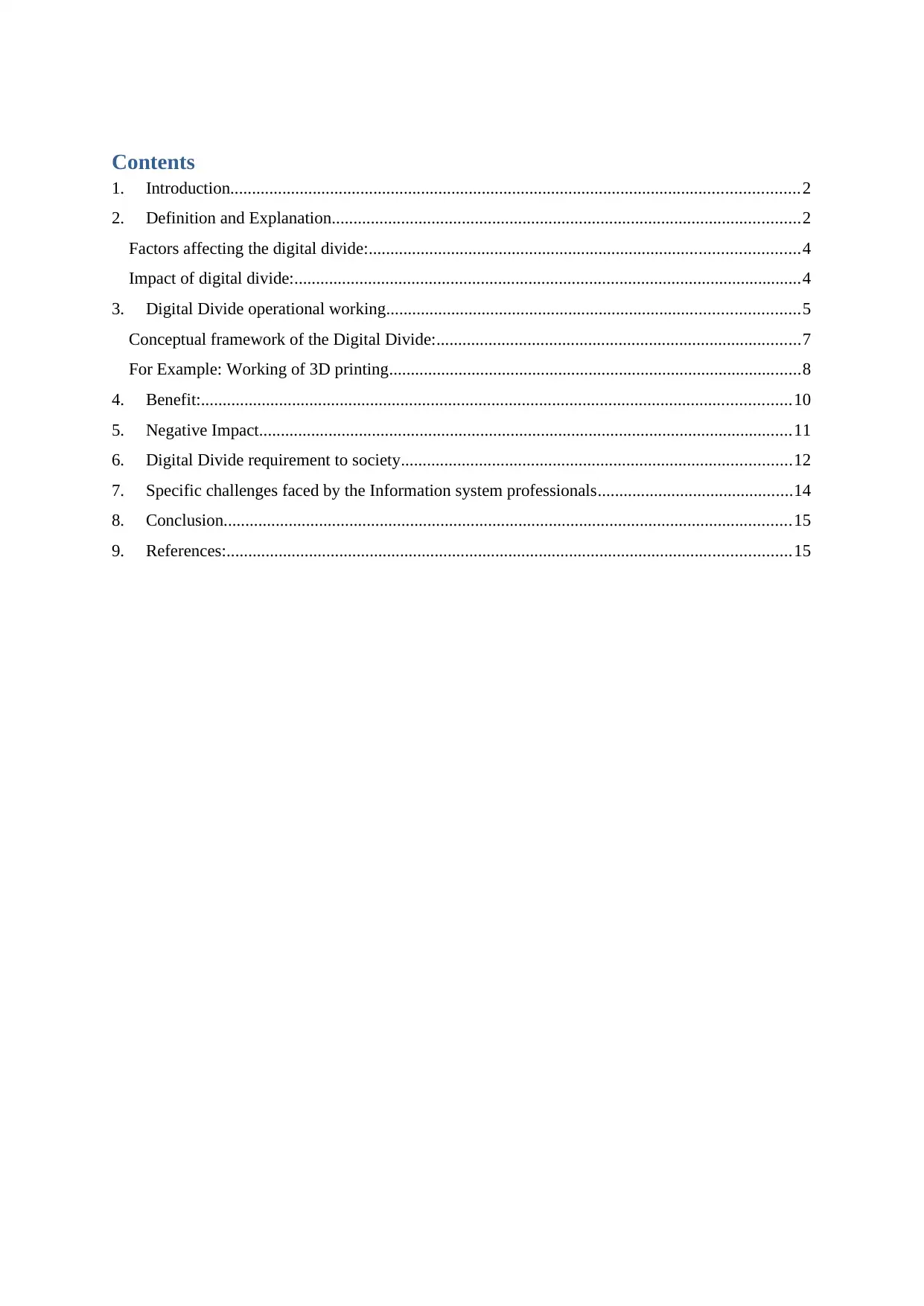
Contents
1. Introduction...................................................................................................................................2
2. Definition and Explanation............................................................................................................2
Factors affecting the digital divide:...................................................................................................4
Impact of digital divide:.....................................................................................................................4
3. Digital Divide operational working...............................................................................................5
Conceptual framework of the Digital Divide:....................................................................................7
For Example: Working of 3D printing...............................................................................................8
4. Benefit:........................................................................................................................................10
5. Negative Impact...........................................................................................................................11
6. Digital Divide requirement to society..........................................................................................12
7. Specific challenges faced by the Information system professionals.............................................14
8. Conclusion...................................................................................................................................15
9. References:..................................................................................................................................15
1. Introduction...................................................................................................................................2
2. Definition and Explanation............................................................................................................2
Factors affecting the digital divide:...................................................................................................4
Impact of digital divide:.....................................................................................................................4
3. Digital Divide operational working...............................................................................................5
Conceptual framework of the Digital Divide:....................................................................................7
For Example: Working of 3D printing...............................................................................................8
4. Benefit:........................................................................................................................................10
5. Negative Impact...........................................................................................................................11
6. Digital Divide requirement to society..........................................................................................12
7. Specific challenges faced by the Information system professionals.............................................14
8. Conclusion...................................................................................................................................15
9. References:..................................................................................................................................15
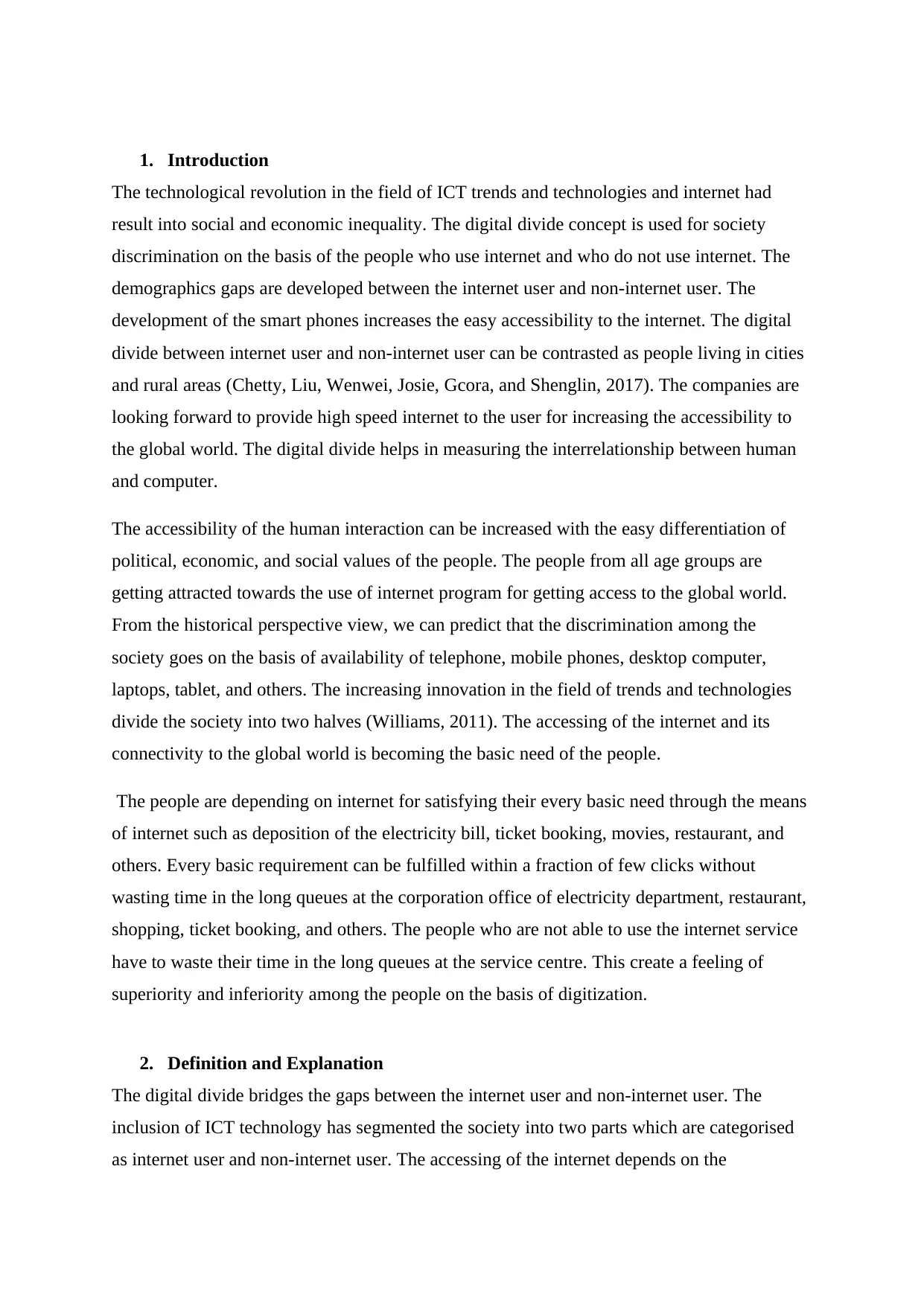
1. Introduction
The technological revolution in the field of ICT trends and technologies and internet had
result into social and economic inequality. The digital divide concept is used for society
discrimination on the basis of the people who use internet and who do not use internet. The
demographics gaps are developed between the internet user and non-internet user. The
development of the smart phones increases the easy accessibility to the internet. The digital
divide between internet user and non-internet user can be contrasted as people living in cities
and rural areas (Chetty, Liu, Wenwei, Josie, Gcora, and Shenglin, 2017). The companies are
looking forward to provide high speed internet to the user for increasing the accessibility to
the global world. The digital divide helps in measuring the interrelationship between human
and computer.
The accessibility of the human interaction can be increased with the easy differentiation of
political, economic, and social values of the people. The people from all age groups are
getting attracted towards the use of internet program for getting access to the global world.
From the historical perspective view, we can predict that the discrimination among the
society goes on the basis of availability of telephone, mobile phones, desktop computer,
laptops, tablet, and others. The increasing innovation in the field of trends and technologies
divide the society into two halves (Williams, 2011). The accessing of the internet and its
connectivity to the global world is becoming the basic need of the people.
The people are depending on internet for satisfying their every basic need through the means
of internet such as deposition of the electricity bill, ticket booking, movies, restaurant, and
others. Every basic requirement can be fulfilled within a fraction of few clicks without
wasting time in the long queues at the corporation office of electricity department, restaurant,
shopping, ticket booking, and others. The people who are not able to use the internet service
have to waste their time in the long queues at the service centre. This create a feeling of
superiority and inferiority among the people on the basis of digitization.
2. Definition and Explanation
The digital divide bridges the gaps between the internet user and non-internet user. The
inclusion of ICT technology has segmented the society into two parts which are categorised
as internet user and non-internet user. The accessing of the internet depends on the
The technological revolution in the field of ICT trends and technologies and internet had
result into social and economic inequality. The digital divide concept is used for society
discrimination on the basis of the people who use internet and who do not use internet. The
demographics gaps are developed between the internet user and non-internet user. The
development of the smart phones increases the easy accessibility to the internet. The digital
divide between internet user and non-internet user can be contrasted as people living in cities
and rural areas (Chetty, Liu, Wenwei, Josie, Gcora, and Shenglin, 2017). The companies are
looking forward to provide high speed internet to the user for increasing the accessibility to
the global world. The digital divide helps in measuring the interrelationship between human
and computer.
The accessibility of the human interaction can be increased with the easy differentiation of
political, economic, and social values of the people. The people from all age groups are
getting attracted towards the use of internet program for getting access to the global world.
From the historical perspective view, we can predict that the discrimination among the
society goes on the basis of availability of telephone, mobile phones, desktop computer,
laptops, tablet, and others. The increasing innovation in the field of trends and technologies
divide the society into two halves (Williams, 2011). The accessing of the internet and its
connectivity to the global world is becoming the basic need of the people.
The people are depending on internet for satisfying their every basic need through the means
of internet such as deposition of the electricity bill, ticket booking, movies, restaurant, and
others. Every basic requirement can be fulfilled within a fraction of few clicks without
wasting time in the long queues at the corporation office of electricity department, restaurant,
shopping, ticket booking, and others. The people who are not able to use the internet service
have to waste their time in the long queues at the service centre. This create a feeling of
superiority and inferiority among the people on the basis of digitization.
2. Definition and Explanation
The digital divide bridges the gaps between the internet user and non-internet user. The
inclusion of ICT technology has segmented the society into two parts which are categorised
as internet user and non-internet user. The accessing of the internet depends on the
⊘ This is a preview!⊘
Do you want full access?
Subscribe today to unlock all pages.

Trusted by 1+ million students worldwide
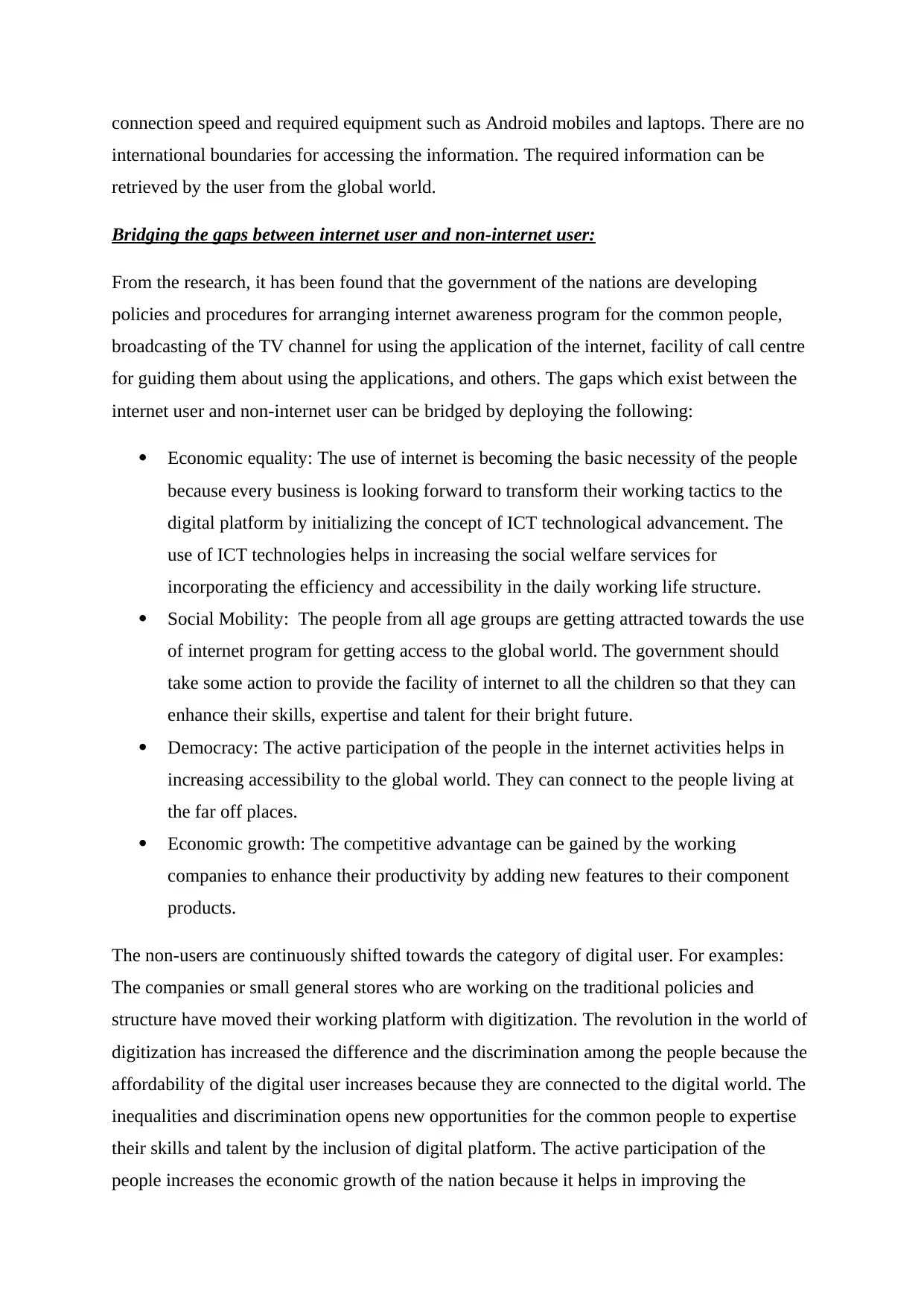
connection speed and required equipment such as Android mobiles and laptops. There are no
international boundaries for accessing the information. The required information can be
retrieved by the user from the global world.
Bridging the gaps between internet user and non-internet user:
From the research, it has been found that the government of the nations are developing
policies and procedures for arranging internet awareness program for the common people,
broadcasting of the TV channel for using the application of the internet, facility of call centre
for guiding them about using the applications, and others. The gaps which exist between the
internet user and non-internet user can be bridged by deploying the following:
Economic equality: The use of internet is becoming the basic necessity of the people
because every business is looking forward to transform their working tactics to the
digital platform by initializing the concept of ICT technological advancement. The
use of ICT technologies helps in increasing the social welfare services for
incorporating the efficiency and accessibility in the daily working life structure.
Social Mobility: The people from all age groups are getting attracted towards the use
of internet program for getting access to the global world. The government should
take some action to provide the facility of internet to all the children so that they can
enhance their skills, expertise and talent for their bright future.
Democracy: The active participation of the people in the internet activities helps in
increasing accessibility to the global world. They can connect to the people living at
the far off places.
Economic growth: The competitive advantage can be gained by the working
companies to enhance their productivity by adding new features to their component
products.
The non-users are continuously shifted towards the category of digital user. For examples:
The companies or small general stores who are working on the traditional policies and
structure have moved their working platform with digitization. The revolution in the world of
digitization has increased the difference and the discrimination among the people because the
affordability of the digital user increases because they are connected to the digital world. The
inequalities and discrimination opens new opportunities for the common people to expertise
their skills and talent by the inclusion of digital platform. The active participation of the
people increases the economic growth of the nation because it helps in improving the
international boundaries for accessing the information. The required information can be
retrieved by the user from the global world.
Bridging the gaps between internet user and non-internet user:
From the research, it has been found that the government of the nations are developing
policies and procedures for arranging internet awareness program for the common people,
broadcasting of the TV channel for using the application of the internet, facility of call centre
for guiding them about using the applications, and others. The gaps which exist between the
internet user and non-internet user can be bridged by deploying the following:
Economic equality: The use of internet is becoming the basic necessity of the people
because every business is looking forward to transform their working tactics to the
digital platform by initializing the concept of ICT technological advancement. The
use of ICT technologies helps in increasing the social welfare services for
incorporating the efficiency and accessibility in the daily working life structure.
Social Mobility: The people from all age groups are getting attracted towards the use
of internet program for getting access to the global world. The government should
take some action to provide the facility of internet to all the children so that they can
enhance their skills, expertise and talent for their bright future.
Democracy: The active participation of the people in the internet activities helps in
increasing accessibility to the global world. They can connect to the people living at
the far off places.
Economic growth: The competitive advantage can be gained by the working
companies to enhance their productivity by adding new features to their component
products.
The non-users are continuously shifted towards the category of digital user. For examples:
The companies or small general stores who are working on the traditional policies and
structure have moved their working platform with digitization. The revolution in the world of
digitization has increased the difference and the discrimination among the people because the
affordability of the digital user increases because they are connected to the digital world. The
inequalities and discrimination opens new opportunities for the common people to expertise
their skills and talent by the inclusion of digital platform. The active participation of the
people increases the economic growth of the nation because it helps in improving the
Paraphrase This Document
Need a fresh take? Get an instant paraphrase of this document with our AI Paraphraser
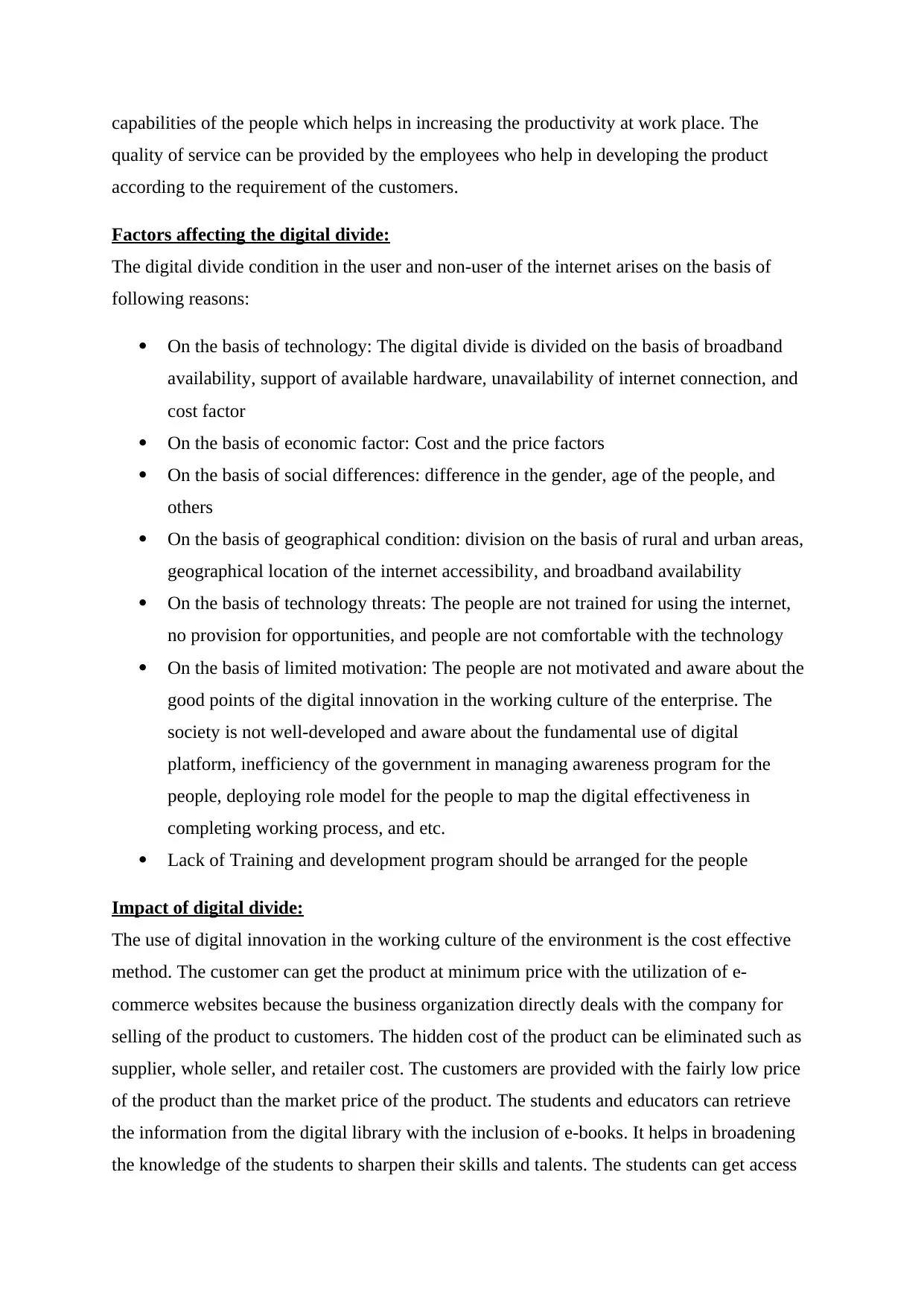
capabilities of the people which helps in increasing the productivity at work place. The
quality of service can be provided by the employees who help in developing the product
according to the requirement of the customers.
Factors affecting the digital divide:
The digital divide condition in the user and non-user of the internet arises on the basis of
following reasons:
On the basis of technology: The digital divide is divided on the basis of broadband
availability, support of available hardware, unavailability of internet connection, and
cost factor
On the basis of economic factor: Cost and the price factors
On the basis of social differences: difference in the gender, age of the people, and
others
On the basis of geographical condition: division on the basis of rural and urban areas,
geographical location of the internet accessibility, and broadband availability
On the basis of technology threats: The people are not trained for using the internet,
no provision for opportunities, and people are not comfortable with the technology
On the basis of limited motivation: The people are not motivated and aware about the
good points of the digital innovation in the working culture of the enterprise. The
society is not well-developed and aware about the fundamental use of digital
platform, inefficiency of the government in managing awareness program for the
people, deploying role model for the people to map the digital effectiveness in
completing working process, and etc.
Lack of Training and development program should be arranged for the people
Impact of digital divide:
The use of digital innovation in the working culture of the environment is the cost effective
method. The customer can get the product at minimum price with the utilization of e-
commerce websites because the business organization directly deals with the company for
selling of the product to customers. The hidden cost of the product can be eliminated such as
supplier, whole seller, and retailer cost. The customers are provided with the fairly low price
of the product than the market price of the product. The students and educators can retrieve
the information from the digital library with the inclusion of e-books. It helps in broadening
the knowledge of the students to sharpen their skills and talents. The students can get access
quality of service can be provided by the employees who help in developing the product
according to the requirement of the customers.
Factors affecting the digital divide:
The digital divide condition in the user and non-user of the internet arises on the basis of
following reasons:
On the basis of technology: The digital divide is divided on the basis of broadband
availability, support of available hardware, unavailability of internet connection, and
cost factor
On the basis of economic factor: Cost and the price factors
On the basis of social differences: difference in the gender, age of the people, and
others
On the basis of geographical condition: division on the basis of rural and urban areas,
geographical location of the internet accessibility, and broadband availability
On the basis of technology threats: The people are not trained for using the internet,
no provision for opportunities, and people are not comfortable with the technology
On the basis of limited motivation: The people are not motivated and aware about the
good points of the digital innovation in the working culture of the enterprise. The
society is not well-developed and aware about the fundamental use of digital
platform, inefficiency of the government in managing awareness program for the
people, deploying role model for the people to map the digital effectiveness in
completing working process, and etc.
Lack of Training and development program should be arranged for the people
Impact of digital divide:
The use of digital innovation in the working culture of the environment is the cost effective
method. The customer can get the product at minimum price with the utilization of e-
commerce websites because the business organization directly deals with the company for
selling of the product to customers. The hidden cost of the product can be eliminated such as
supplier, whole seller, and retailer cost. The customers are provided with the fairly low price
of the product than the market price of the product. The students and educators can retrieve
the information from the digital library with the inclusion of e-books. It helps in broadening
the knowledge of the students to sharpen their skills and talents. The students can get access
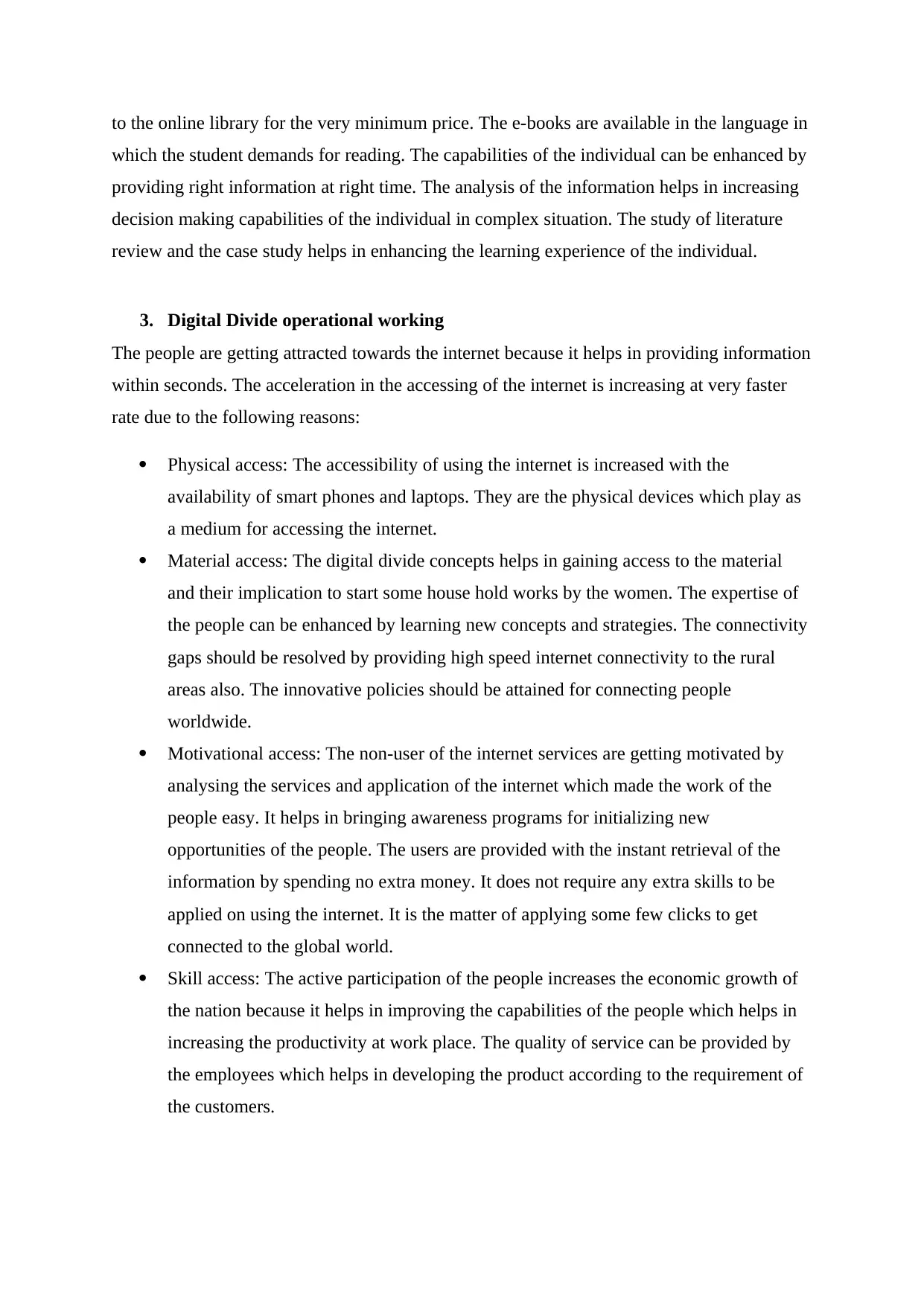
to the online library for the very minimum price. The e-books are available in the language in
which the student demands for reading. The capabilities of the individual can be enhanced by
providing right information at right time. The analysis of the information helps in increasing
decision making capabilities of the individual in complex situation. The study of literature
review and the case study helps in enhancing the learning experience of the individual.
3. Digital Divide operational working
The people are getting attracted towards the internet because it helps in providing information
within seconds. The acceleration in the accessing of the internet is increasing at very faster
rate due to the following reasons:
Physical access: The accessibility of using the internet is increased with the
availability of smart phones and laptops. They are the physical devices which play as
a medium for accessing the internet.
Material access: The digital divide concepts helps in gaining access to the material
and their implication to start some house hold works by the women. The expertise of
the people can be enhanced by learning new concepts and strategies. The connectivity
gaps should be resolved by providing high speed internet connectivity to the rural
areas also. The innovative policies should be attained for connecting people
worldwide.
Motivational access: The non-user of the internet services are getting motivated by
analysing the services and application of the internet which made the work of the
people easy. It helps in bringing awareness programs for initializing new
opportunities of the people. The users are provided with the instant retrieval of the
information by spending no extra money. It does not require any extra skills to be
applied on using the internet. It is the matter of applying some few clicks to get
connected to the global world.
Skill access: The active participation of the people increases the economic growth of
the nation because it helps in improving the capabilities of the people which helps in
increasing the productivity at work place. The quality of service can be provided by
the employees which helps in developing the product according to the requirement of
the customers.
which the student demands for reading. The capabilities of the individual can be enhanced by
providing right information at right time. The analysis of the information helps in increasing
decision making capabilities of the individual in complex situation. The study of literature
review and the case study helps in enhancing the learning experience of the individual.
3. Digital Divide operational working
The people are getting attracted towards the internet because it helps in providing information
within seconds. The acceleration in the accessing of the internet is increasing at very faster
rate due to the following reasons:
Physical access: The accessibility of using the internet is increased with the
availability of smart phones and laptops. They are the physical devices which play as
a medium for accessing the internet.
Material access: The digital divide concepts helps in gaining access to the material
and their implication to start some house hold works by the women. The expertise of
the people can be enhanced by learning new concepts and strategies. The connectivity
gaps should be resolved by providing high speed internet connectivity to the rural
areas also. The innovative policies should be attained for connecting people
worldwide.
Motivational access: The non-user of the internet services are getting motivated by
analysing the services and application of the internet which made the work of the
people easy. It helps in bringing awareness programs for initializing new
opportunities of the people. The users are provided with the instant retrieval of the
information by spending no extra money. It does not require any extra skills to be
applied on using the internet. It is the matter of applying some few clicks to get
connected to the global world.
Skill access: The active participation of the people increases the economic growth of
the nation because it helps in improving the capabilities of the people which helps in
increasing the productivity at work place. The quality of service can be provided by
the employees which helps in developing the product according to the requirement of
the customers.
⊘ This is a preview!⊘
Do you want full access?
Subscribe today to unlock all pages.

Trusted by 1+ million students worldwide
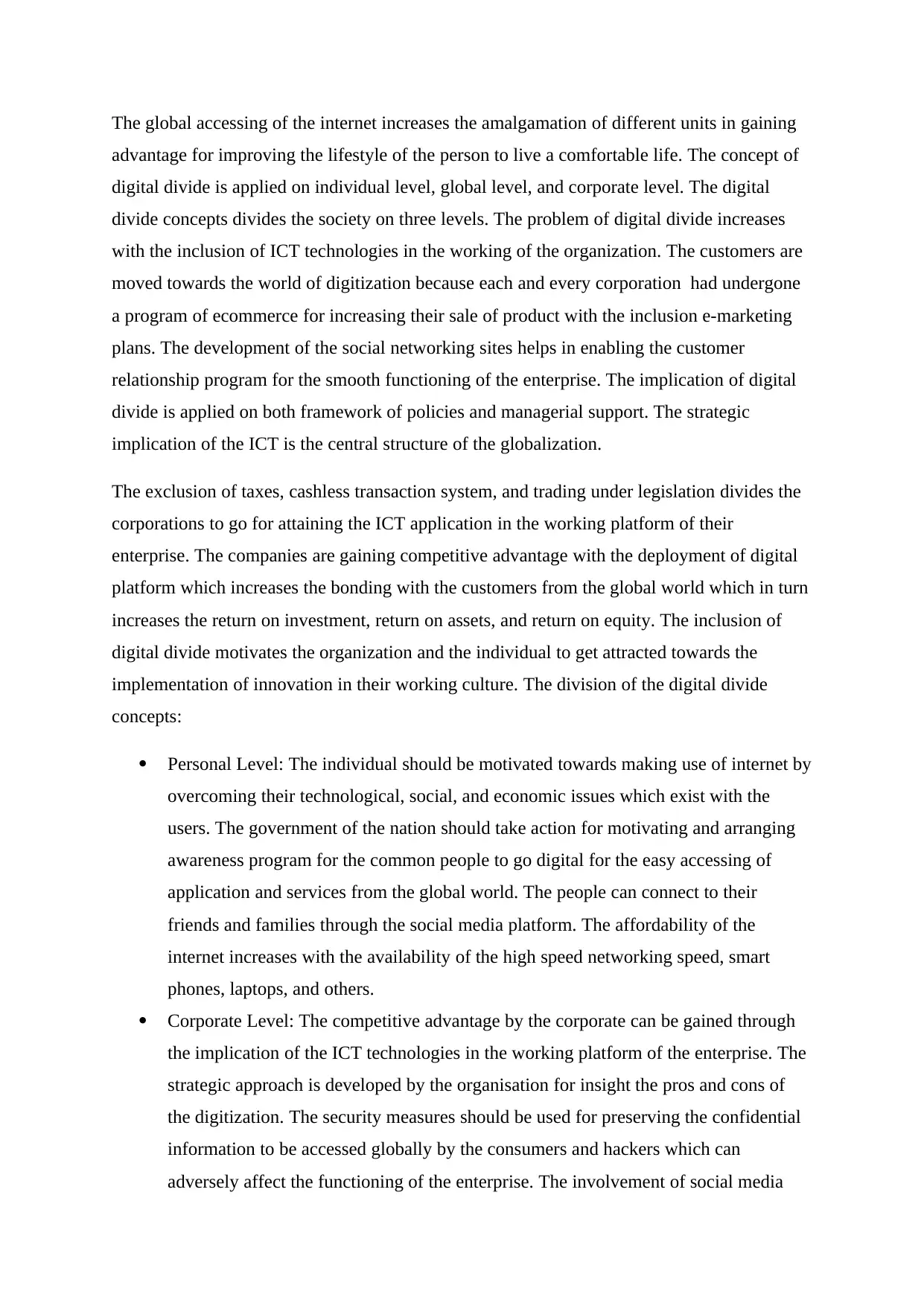
The global accessing of the internet increases the amalgamation of different units in gaining
advantage for improving the lifestyle of the person to live a comfortable life. The concept of
digital divide is applied on individual level, global level, and corporate level. The digital
divide concepts divides the society on three levels. The problem of digital divide increases
with the inclusion of ICT technologies in the working of the organization. The customers are
moved towards the world of digitization because each and every corporation had undergone
a program of ecommerce for increasing their sale of product with the inclusion e-marketing
plans. The development of the social networking sites helps in enabling the customer
relationship program for the smooth functioning of the enterprise. The implication of digital
divide is applied on both framework of policies and managerial support. The strategic
implication of the ICT is the central structure of the globalization.
The exclusion of taxes, cashless transaction system, and trading under legislation divides the
corporations to go for attaining the ICT application in the working platform of their
enterprise. The companies are gaining competitive advantage with the deployment of digital
platform which increases the bonding with the customers from the global world which in turn
increases the return on investment, return on assets, and return on equity. The inclusion of
digital divide motivates the organization and the individual to get attracted towards the
implementation of innovation in their working culture. The division of the digital divide
concepts:
Personal Level: The individual should be motivated towards making use of internet by
overcoming their technological, social, and economic issues which exist with the
users. The government of the nation should take action for motivating and arranging
awareness program for the common people to go digital for the easy accessing of
application and services from the global world. The people can connect to their
friends and families through the social media platform. The affordability of the
internet increases with the availability of the high speed networking speed, smart
phones, laptops, and others.
Corporate Level: The competitive advantage by the corporate can be gained through
the implication of the ICT technologies in the working platform of the enterprise. The
strategic approach is developed by the organisation for insight the pros and cons of
the digitization. The security measures should be used for preserving the confidential
information to be accessed globally by the consumers and hackers which can
adversely affect the functioning of the enterprise. The involvement of social media
advantage for improving the lifestyle of the person to live a comfortable life. The concept of
digital divide is applied on individual level, global level, and corporate level. The digital
divide concepts divides the society on three levels. The problem of digital divide increases
with the inclusion of ICT technologies in the working of the organization. The customers are
moved towards the world of digitization because each and every corporation had undergone
a program of ecommerce for increasing their sale of product with the inclusion e-marketing
plans. The development of the social networking sites helps in enabling the customer
relationship program for the smooth functioning of the enterprise. The implication of digital
divide is applied on both framework of policies and managerial support. The strategic
implication of the ICT is the central structure of the globalization.
The exclusion of taxes, cashless transaction system, and trading under legislation divides the
corporations to go for attaining the ICT application in the working platform of their
enterprise. The companies are gaining competitive advantage with the deployment of digital
platform which increases the bonding with the customers from the global world which in turn
increases the return on investment, return on assets, and return on equity. The inclusion of
digital divide motivates the organization and the individual to get attracted towards the
implementation of innovation in their working culture. The division of the digital divide
concepts:
Personal Level: The individual should be motivated towards making use of internet by
overcoming their technological, social, and economic issues which exist with the
users. The government of the nation should take action for motivating and arranging
awareness program for the common people to go digital for the easy accessing of
application and services from the global world. The people can connect to their
friends and families through the social media platform. The affordability of the
internet increases with the availability of the high speed networking speed, smart
phones, laptops, and others.
Corporate Level: The competitive advantage by the corporate can be gained through
the implication of the ICT technologies in the working platform of the enterprise. The
strategic approach is developed by the organisation for insight the pros and cons of
the digitization. The security measures should be used for preserving the confidential
information to be accessed globally by the consumers and hackers which can
adversely affect the functioning of the enterprise. The involvement of social media
Paraphrase This Document
Need a fresh take? Get an instant paraphrase of this document with our AI Paraphraser
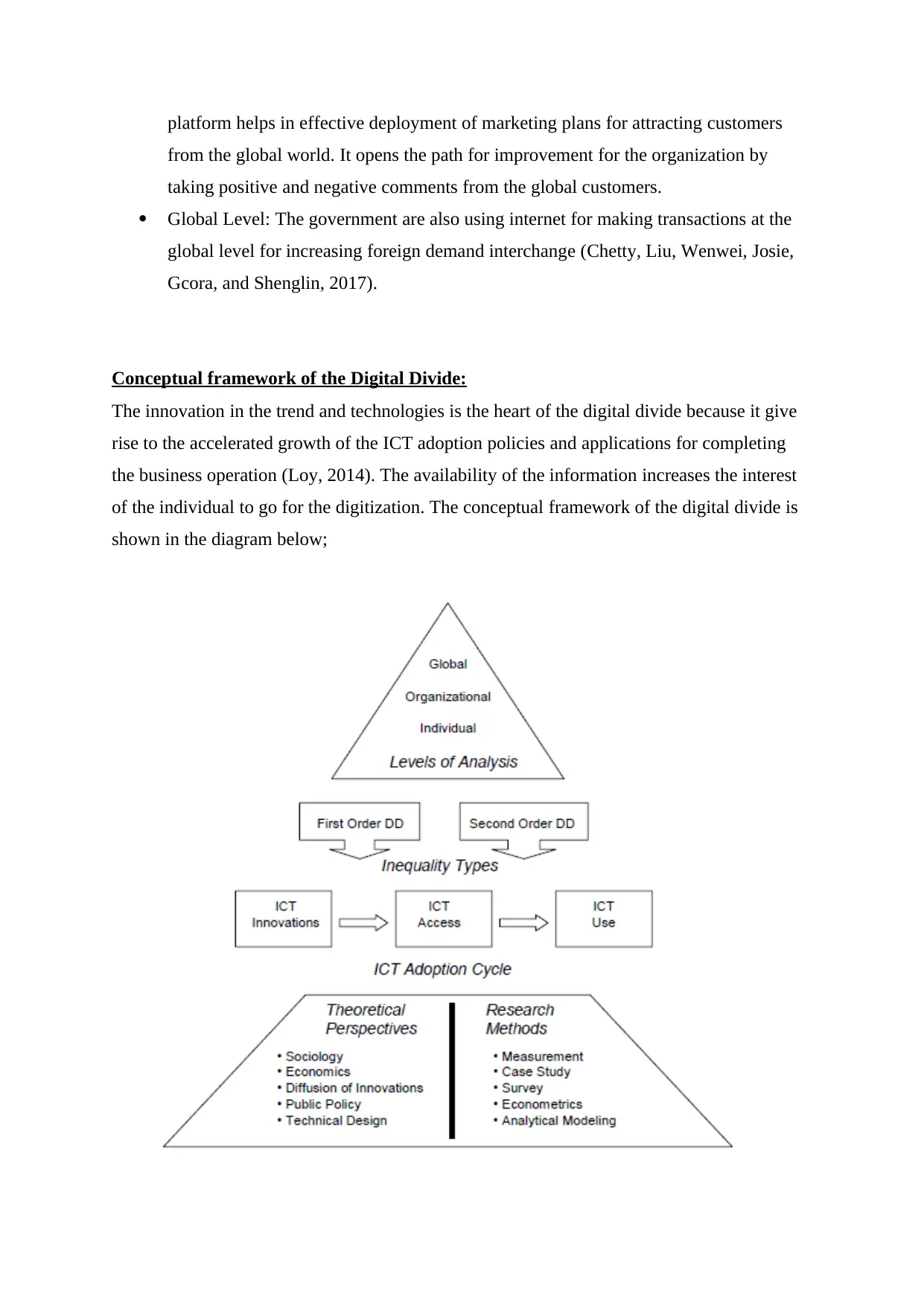
platform helps in effective deployment of marketing plans for attracting customers
from the global world. It opens the path for improvement for the organization by
taking positive and negative comments from the global customers.
Global Level: The government are also using internet for making transactions at the
global level for increasing foreign demand interchange (Chetty, Liu, Wenwei, Josie,
Gcora, and Shenglin, 2017).
Conceptual framework of the Digital Divide:
The innovation in the trend and technologies is the heart of the digital divide because it give
rise to the accelerated growth of the ICT adoption policies and applications for completing
the business operation (Loy, 2014). The availability of the information increases the interest
of the individual to go for the digitization. The conceptual framework of the digital divide is
shown in the diagram below;
from the global world. It opens the path for improvement for the organization by
taking positive and negative comments from the global customers.
Global Level: The government are also using internet for making transactions at the
global level for increasing foreign demand interchange (Chetty, Liu, Wenwei, Josie,
Gcora, and Shenglin, 2017).
Conceptual framework of the Digital Divide:
The innovation in the trend and technologies is the heart of the digital divide because it give
rise to the accelerated growth of the ICT adoption policies and applications for completing
the business operation (Loy, 2014). The availability of the information increases the interest
of the individual to go for the digitization. The conceptual framework of the digital divide is
shown in the diagram below;
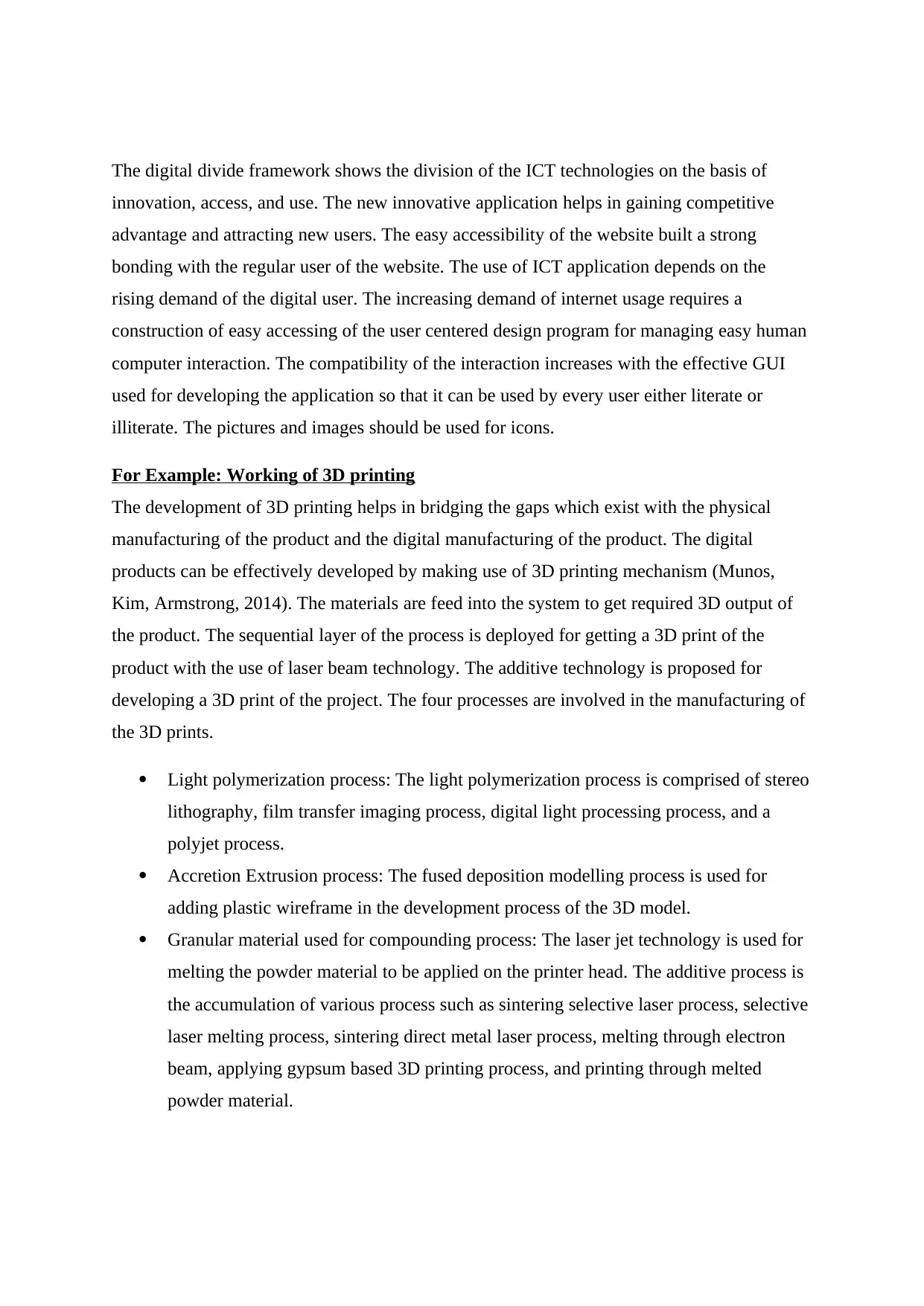
The digital divide framework shows the division of the ICT technologies on the basis of
innovation, access, and use. The new innovative application helps in gaining competitive
advantage and attracting new users. The easy accessibility of the website built a strong
bonding with the regular user of the website. The use of ICT application depends on the
rising demand of the digital user. The increasing demand of internet usage requires a
construction of easy accessing of the user centered design program for managing easy human
computer interaction. The compatibility of the interaction increases with the effective GUI
used for developing the application so that it can be used by every user either literate or
illiterate. The pictures and images should be used for icons.
For Example: Working of 3D printing
The development of 3D printing helps in bridging the gaps which exist with the physical
manufacturing of the product and the digital manufacturing of the product. The digital
products can be effectively developed by making use of 3D printing mechanism (Munos,
Kim, Armstrong, 2014). The materials are feed into the system to get required 3D output of
the product. The sequential layer of the process is deployed for getting a 3D print of the
product with the use of laser beam technology. The additive technology is proposed for
developing a 3D print of the project. The four processes are involved in the manufacturing of
the 3D prints.
Light polymerization process: The light polymerization process is comprised of stereo
lithography, film transfer imaging process, digital light processing process, and a
polyjet process.
Accretion Extrusion process: The fused deposition modelling process is used for
adding plastic wireframe in the development process of the 3D model.
Granular material used for compounding process: The laser jet technology is used for
melting the powder material to be applied on the printer head. The additive process is
the accumulation of various process such as sintering selective laser process, selective
laser melting process, sintering direct metal laser process, melting through electron
beam, applying gypsum based 3D printing process, and printing through melted
powder material.
innovation, access, and use. The new innovative application helps in gaining competitive
advantage and attracting new users. The easy accessibility of the website built a strong
bonding with the regular user of the website. The use of ICT application depends on the
rising demand of the digital user. The increasing demand of internet usage requires a
construction of easy accessing of the user centered design program for managing easy human
computer interaction. The compatibility of the interaction increases with the effective GUI
used for developing the application so that it can be used by every user either literate or
illiterate. The pictures and images should be used for icons.
For Example: Working of 3D printing
The development of 3D printing helps in bridging the gaps which exist with the physical
manufacturing of the product and the digital manufacturing of the product. The digital
products can be effectively developed by making use of 3D printing mechanism (Munos,
Kim, Armstrong, 2014). The materials are feed into the system to get required 3D output of
the product. The sequential layer of the process is deployed for getting a 3D print of the
product with the use of laser beam technology. The additive technology is proposed for
developing a 3D print of the project. The four processes are involved in the manufacturing of
the 3D prints.
Light polymerization process: The light polymerization process is comprised of stereo
lithography, film transfer imaging process, digital light processing process, and a
polyjet process.
Accretion Extrusion process: The fused deposition modelling process is used for
adding plastic wireframe in the development process of the 3D model.
Granular material used for compounding process: The laser jet technology is used for
melting the powder material to be applied on the printer head. The additive process is
the accumulation of various process such as sintering selective laser process, selective
laser melting process, sintering direct metal laser process, melting through electron
beam, applying gypsum based 3D printing process, and printing through melted
powder material.
⊘ This is a preview!⊘
Do you want full access?
Subscribe today to unlock all pages.

Trusted by 1+ million students worldwide
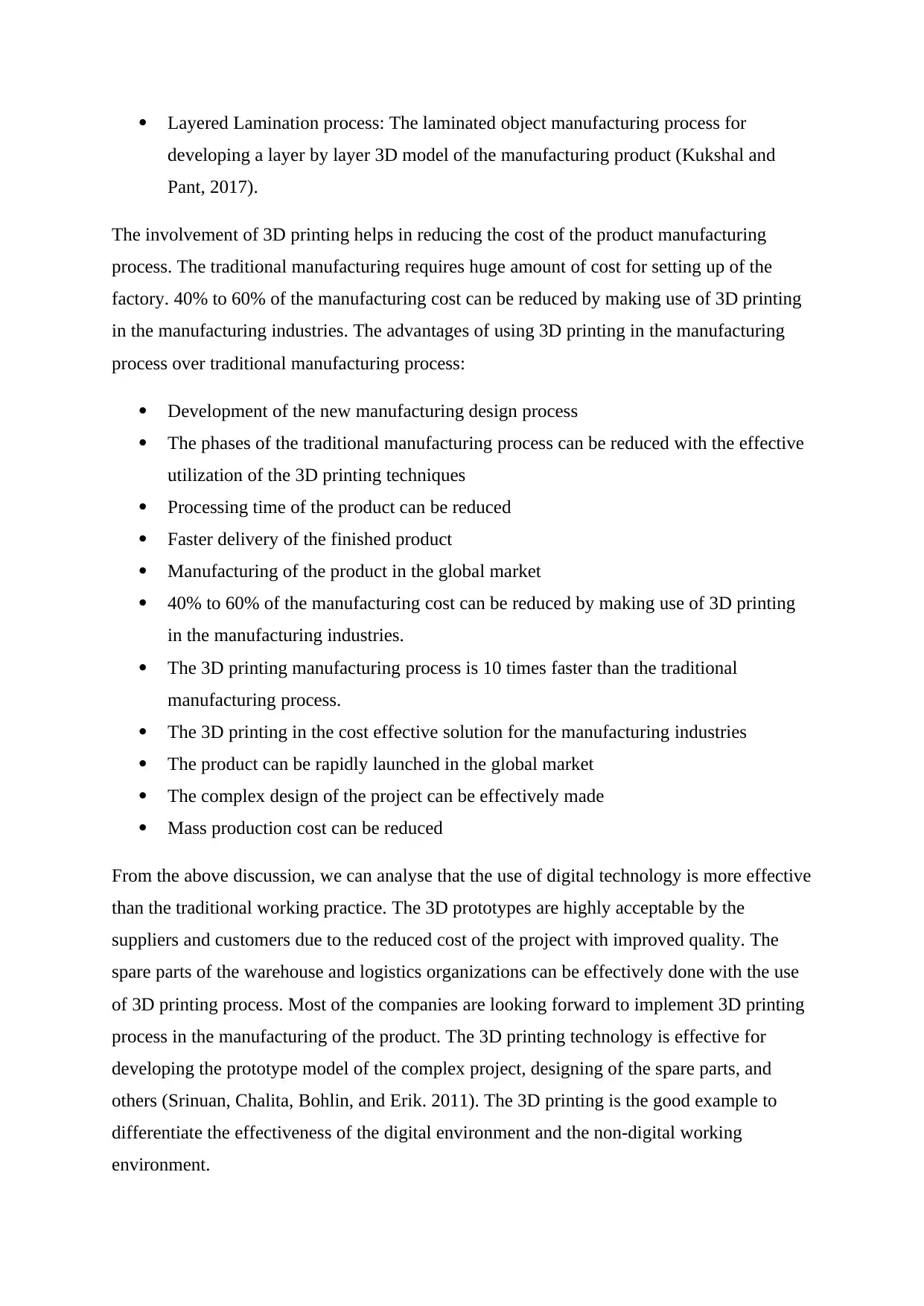
Layered Lamination process: The laminated object manufacturing process for
developing a layer by layer 3D model of the manufacturing product (Kukshal and
Pant, 2017).
The involvement of 3D printing helps in reducing the cost of the product manufacturing
process. The traditional manufacturing requires huge amount of cost for setting up of the
factory. 40% to 60% of the manufacturing cost can be reduced by making use of 3D printing
in the manufacturing industries. The advantages of using 3D printing in the manufacturing
process over traditional manufacturing process:
Development of the new manufacturing design process
The phases of the traditional manufacturing process can be reduced with the effective
utilization of the 3D printing techniques
Processing time of the product can be reduced
Faster delivery of the finished product
Manufacturing of the product in the global market
40% to 60% of the manufacturing cost can be reduced by making use of 3D printing
in the manufacturing industries.
The 3D printing manufacturing process is 10 times faster than the traditional
manufacturing process.
The 3D printing in the cost effective solution for the manufacturing industries
The product can be rapidly launched in the global market
The complex design of the project can be effectively made
Mass production cost can be reduced
From the above discussion, we can analyse that the use of digital technology is more effective
than the traditional working practice. The 3D prototypes are highly acceptable by the
suppliers and customers due to the reduced cost of the project with improved quality. The
spare parts of the warehouse and logistics organizations can be effectively done with the use
of 3D printing process. Most of the companies are looking forward to implement 3D printing
process in the manufacturing of the product. The 3D printing technology is effective for
developing the prototype model of the complex project, designing of the spare parts, and
others (Srinuan, Chalita, Bohlin, and Erik. 2011). The 3D printing is the good example to
differentiate the effectiveness of the digital environment and the non-digital working
environment.
developing a layer by layer 3D model of the manufacturing product (Kukshal and
Pant, 2017).
The involvement of 3D printing helps in reducing the cost of the product manufacturing
process. The traditional manufacturing requires huge amount of cost for setting up of the
factory. 40% to 60% of the manufacturing cost can be reduced by making use of 3D printing
in the manufacturing industries. The advantages of using 3D printing in the manufacturing
process over traditional manufacturing process:
Development of the new manufacturing design process
The phases of the traditional manufacturing process can be reduced with the effective
utilization of the 3D printing techniques
Processing time of the product can be reduced
Faster delivery of the finished product
Manufacturing of the product in the global market
40% to 60% of the manufacturing cost can be reduced by making use of 3D printing
in the manufacturing industries.
The 3D printing manufacturing process is 10 times faster than the traditional
manufacturing process.
The 3D printing in the cost effective solution for the manufacturing industries
The product can be rapidly launched in the global market
The complex design of the project can be effectively made
Mass production cost can be reduced
From the above discussion, we can analyse that the use of digital technology is more effective
than the traditional working practice. The 3D prototypes are highly acceptable by the
suppliers and customers due to the reduced cost of the project with improved quality. The
spare parts of the warehouse and logistics organizations can be effectively done with the use
of 3D printing process. Most of the companies are looking forward to implement 3D printing
process in the manufacturing of the product. The 3D printing technology is effective for
developing the prototype model of the complex project, designing of the spare parts, and
others (Srinuan, Chalita, Bohlin, and Erik. 2011). The 3D printing is the good example to
differentiate the effectiveness of the digital environment and the non-digital working
environment.
Paraphrase This Document
Need a fresh take? Get an instant paraphrase of this document with our AI Paraphraser
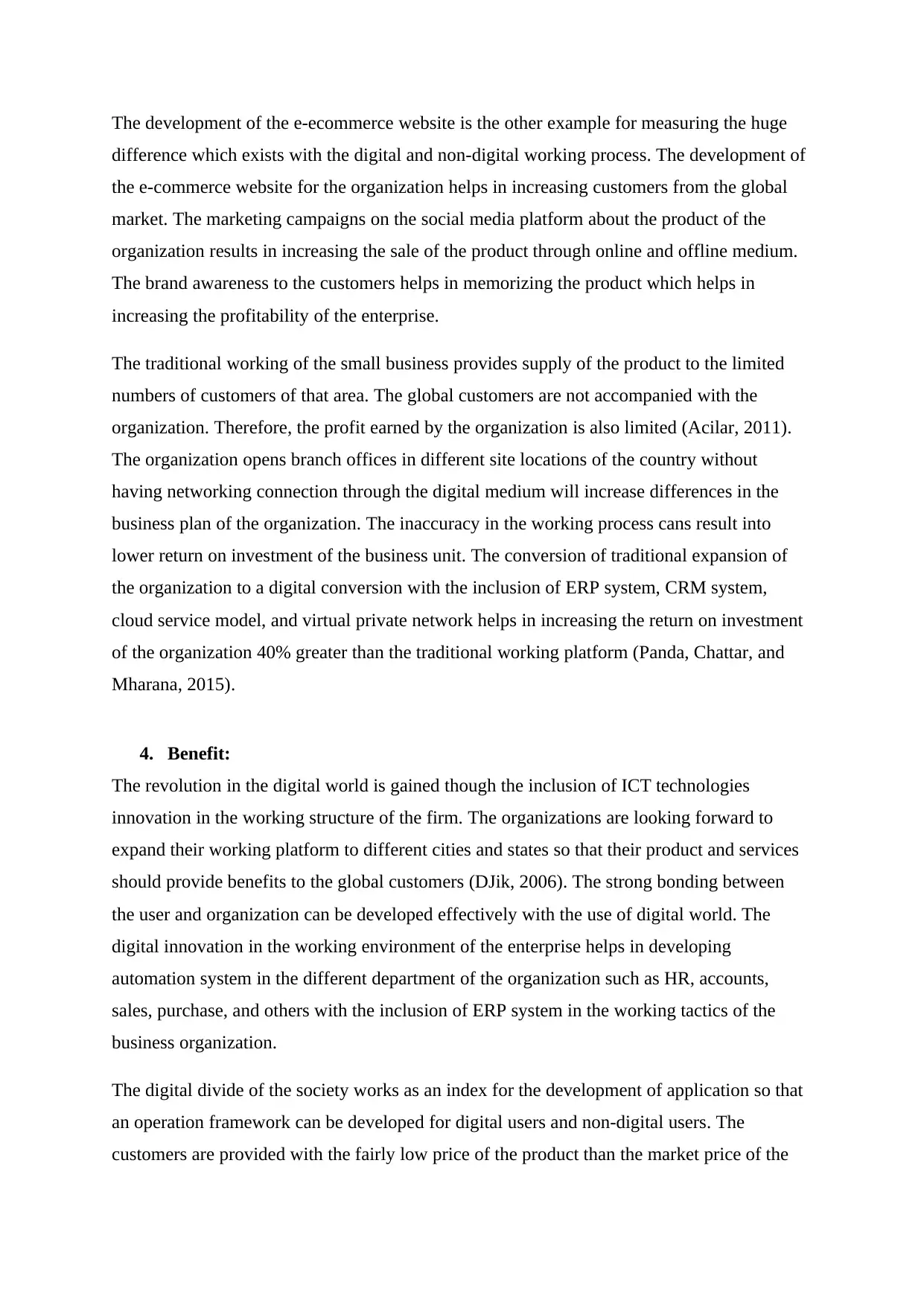
The development of the e-ecommerce website is the other example for measuring the huge
difference which exists with the digital and non-digital working process. The development of
the e-commerce website for the organization helps in increasing customers from the global
market. The marketing campaigns on the social media platform about the product of the
organization results in increasing the sale of the product through online and offline medium.
The brand awareness to the customers helps in memorizing the product which helps in
increasing the profitability of the enterprise.
The traditional working of the small business provides supply of the product to the limited
numbers of customers of that area. The global customers are not accompanied with the
organization. Therefore, the profit earned by the organization is also limited (Acilar, 2011).
The organization opens branch offices in different site locations of the country without
having networking connection through the digital medium will increase differences in the
business plan of the organization. The inaccuracy in the working process cans result into
lower return on investment of the business unit. The conversion of traditional expansion of
the organization to a digital conversion with the inclusion of ERP system, CRM system,
cloud service model, and virtual private network helps in increasing the return on investment
of the organization 40% greater than the traditional working platform (Panda, Chattar, and
Mharana, 2015).
4. Benefit:
The revolution in the digital world is gained though the inclusion of ICT technologies
innovation in the working structure of the firm. The organizations are looking forward to
expand their working platform to different cities and states so that their product and services
should provide benefits to the global customers (DJik, 2006). The strong bonding between
the user and organization can be developed effectively with the use of digital world. The
digital innovation in the working environment of the enterprise helps in developing
automation system in the different department of the organization such as HR, accounts,
sales, purchase, and others with the inclusion of ERP system in the working tactics of the
business organization.
The digital divide of the society works as an index for the development of application so that
an operation framework can be developed for digital users and non-digital users. The
customers are provided with the fairly low price of the product than the market price of the
difference which exists with the digital and non-digital working process. The development of
the e-commerce website for the organization helps in increasing customers from the global
market. The marketing campaigns on the social media platform about the product of the
organization results in increasing the sale of the product through online and offline medium.
The brand awareness to the customers helps in memorizing the product which helps in
increasing the profitability of the enterprise.
The traditional working of the small business provides supply of the product to the limited
numbers of customers of that area. The global customers are not accompanied with the
organization. Therefore, the profit earned by the organization is also limited (Acilar, 2011).
The organization opens branch offices in different site locations of the country without
having networking connection through the digital medium will increase differences in the
business plan of the organization. The inaccuracy in the working process cans result into
lower return on investment of the business unit. The conversion of traditional expansion of
the organization to a digital conversion with the inclusion of ERP system, CRM system,
cloud service model, and virtual private network helps in increasing the return on investment
of the organization 40% greater than the traditional working platform (Panda, Chattar, and
Mharana, 2015).
4. Benefit:
The revolution in the digital world is gained though the inclusion of ICT technologies
innovation in the working structure of the firm. The organizations are looking forward to
expand their working platform to different cities and states so that their product and services
should provide benefits to the global customers (DJik, 2006). The strong bonding between
the user and organization can be developed effectively with the use of digital world. The
digital innovation in the working environment of the enterprise helps in developing
automation system in the different department of the organization such as HR, accounts,
sales, purchase, and others with the inclusion of ERP system in the working tactics of the
business organization.
The digital divide of the society works as an index for the development of application so that
an operation framework can be developed for digital users and non-digital users. The
customers are provided with the fairly low price of the product than the market price of the
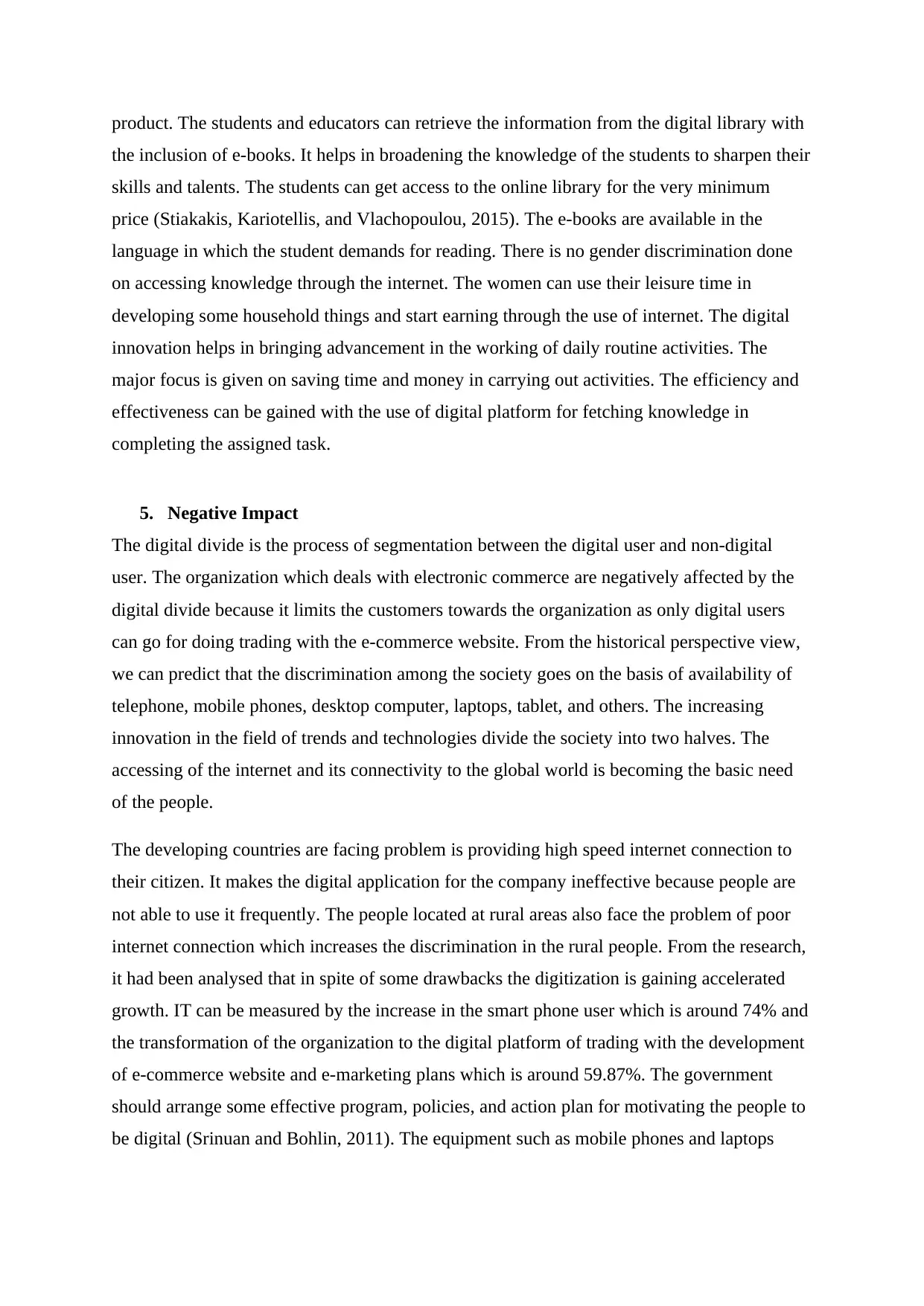
product. The students and educators can retrieve the information from the digital library with
the inclusion of e-books. It helps in broadening the knowledge of the students to sharpen their
skills and talents. The students can get access to the online library for the very minimum
price (Stiakakis, Kariotellis, and Vlachopoulou, 2015). The e-books are available in the
language in which the student demands for reading. There is no gender discrimination done
on accessing knowledge through the internet. The women can use their leisure time in
developing some household things and start earning through the use of internet. The digital
innovation helps in bringing advancement in the working of daily routine activities. The
major focus is given on saving time and money in carrying out activities. The efficiency and
effectiveness can be gained with the use of digital platform for fetching knowledge in
completing the assigned task.
5. Negative Impact
The digital divide is the process of segmentation between the digital user and non-digital
user. The organization which deals with electronic commerce are negatively affected by the
digital divide because it limits the customers towards the organization as only digital users
can go for doing trading with the e-commerce website. From the historical perspective view,
we can predict that the discrimination among the society goes on the basis of availability of
telephone, mobile phones, desktop computer, laptops, tablet, and others. The increasing
innovation in the field of trends and technologies divide the society into two halves. The
accessing of the internet and its connectivity to the global world is becoming the basic need
of the people.
The developing countries are facing problem is providing high speed internet connection to
their citizen. It makes the digital application for the company ineffective because people are
not able to use it frequently. The people located at rural areas also face the problem of poor
internet connection which increases the discrimination in the rural people. From the research,
it had been analysed that in spite of some drawbacks the digitization is gaining accelerated
growth. IT can be measured by the increase in the smart phone user which is around 74% and
the transformation of the organization to the digital platform of trading with the development
of e-commerce website and e-marketing plans which is around 59.87%. The government
should arrange some effective program, policies, and action plan for motivating the people to
be digital (Srinuan and Bohlin, 2011). The equipment such as mobile phones and laptops
the inclusion of e-books. It helps in broadening the knowledge of the students to sharpen their
skills and talents. The students can get access to the online library for the very minimum
price (Stiakakis, Kariotellis, and Vlachopoulou, 2015). The e-books are available in the
language in which the student demands for reading. There is no gender discrimination done
on accessing knowledge through the internet. The women can use their leisure time in
developing some household things and start earning through the use of internet. The digital
innovation helps in bringing advancement in the working of daily routine activities. The
major focus is given on saving time and money in carrying out activities. The efficiency and
effectiveness can be gained with the use of digital platform for fetching knowledge in
completing the assigned task.
5. Negative Impact
The digital divide is the process of segmentation between the digital user and non-digital
user. The organization which deals with electronic commerce are negatively affected by the
digital divide because it limits the customers towards the organization as only digital users
can go for doing trading with the e-commerce website. From the historical perspective view,
we can predict that the discrimination among the society goes on the basis of availability of
telephone, mobile phones, desktop computer, laptops, tablet, and others. The increasing
innovation in the field of trends and technologies divide the society into two halves. The
accessing of the internet and its connectivity to the global world is becoming the basic need
of the people.
The developing countries are facing problem is providing high speed internet connection to
their citizen. It makes the digital application for the company ineffective because people are
not able to use it frequently. The people located at rural areas also face the problem of poor
internet connection which increases the discrimination in the rural people. From the research,
it had been analysed that in spite of some drawbacks the digitization is gaining accelerated
growth. IT can be measured by the increase in the smart phone user which is around 74% and
the transformation of the organization to the digital platform of trading with the development
of e-commerce website and e-marketing plans which is around 59.87%. The government
should arrange some effective program, policies, and action plan for motivating the people to
be digital (Srinuan and Bohlin, 2011). The equipment such as mobile phones and laptops
⊘ This is a preview!⊘
Do you want full access?
Subscribe today to unlock all pages.

Trusted by 1+ million students worldwide
1 out of 18
Related Documents
Your All-in-One AI-Powered Toolkit for Academic Success.
+13062052269
info@desklib.com
Available 24*7 on WhatsApp / Email
![[object Object]](/_next/static/media/star-bottom.7253800d.svg)
Unlock your academic potential
Copyright © 2020–2025 A2Z Services. All Rights Reserved. Developed and managed by ZUCOL.





